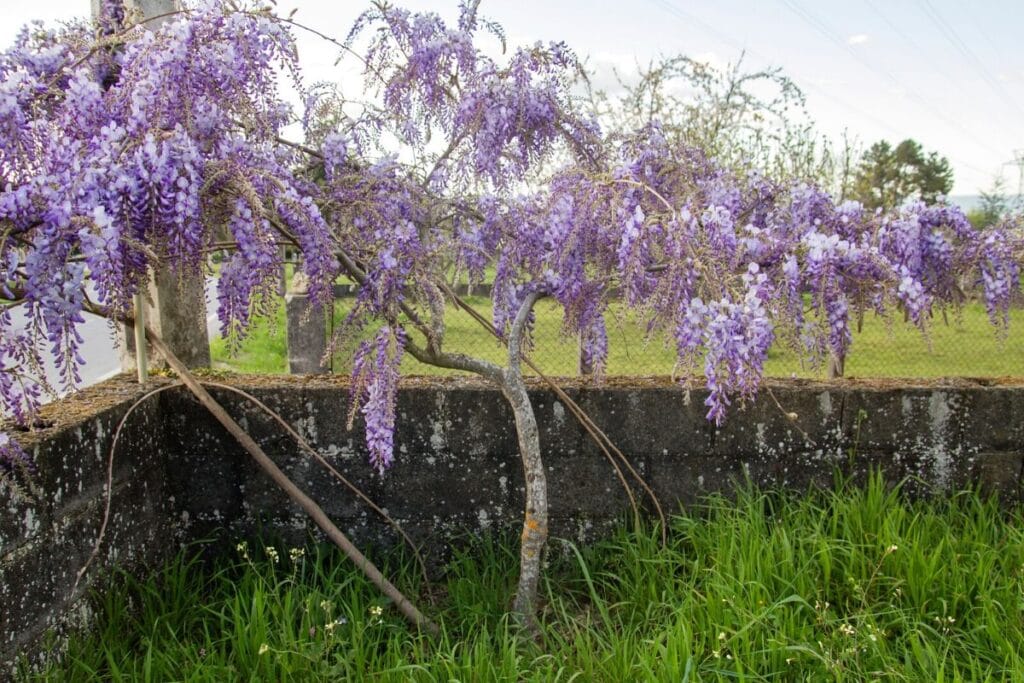While just about everybody is aware that the wisteria plant is a gorgeous vining shrub that is grown most often in the shrub, very few people know that this plant is actually a member of the pea family.
Even fewer are aware of the deep symbolic flower meanings behind the plant. With all kinds of colors – including lavender, blue, and red – this flower has a different symbolic meaning depending on the color and culture, too. In Japan, for instance, the wisteria maiden represents the spirit of wisteria.
What Does Wisteria Mean?
To understand the wisteria flower meaning, we need to dive into the scientific name first. The scientific name of wisteria was bestowed upon the plant by botanist Thomas Nuttall. He named the genus “Wistaria” after a professor of anatomy and anthropology named Dr. Caspar Wistar.
There are more than 20 species of this flower that are recognized, including Wisteria sinensis, Wisteria floribunda, and Wisteria frutescens, just to name a few.

What Does a Wisteria Symbolize?
The wisteria flower has many different meanings to different people. With its lush, warm beauty, the plant represents love, fertility beauty, creativity, and long life. It can also symbolize things like patience and honor, too.
The flower can live for more than 100 years, so it’s often regarded as a symbol of everlasting wisdom. The long, climbing vines are seen as constantly searching for new knowledge. Therefore, it can also be viewed as a symbol of longevity and endurance, too.
What Does a Pink Wisteria Mean?
Pink wisteria usually symbolizes romance. This plant is often used in weddings for this reason.
What Does a White Wisteria Symbolize?
Similar to white roses, white wisteria flowers usually are meant to be viewed as a symbol of spirituality, purity, and innocence.
What Does a Blue Wisteria Symbolize?
Blue wisteria flowers represent a symbol of a new beginning.
What is the Cultural Significance of a Wisteria?
Wisteria plants have been grown in places like Japan, Korea, and China for well over 2,000 years. They arrived in the United States in the mid-1800s as ornamental plants. First referred to as the “blue vine,” these plants were named by botanist Thomas Nuttall.
Practitioners of Feng shui hold the wisteria plant in special regard. It is used as a source of encouragement during moments of doubt. In Japan, the Japanese wisteria plants are seen as being durable and resilient. In China, the wisteria is referred to as Chinese wisteria.
Wisteria can also be trained as a bonsai tree. You can find wisteria bonsai in many nurseries.
The wisteria vine has meaning for Buddhists, too. In fact, in the Jodo Shinshu Shin Buddhist sect, the symbol has two conjoined racemes of wisteria. This represents humility to the sect. It also serves as a symbol of prayer.
In Victorian culture, wisteria vines were viewed as a warning against over passionate love. You can understand this interpretation by looking at the plant as the vines cling together and choke each other out.
What is the Symbolism of a Wisteria Tattoo?
There are plenty of good reasons to get a wisteria tattoo. It’s often viewed as a symbol of prayer or thoughtful reverence, so getting a wisteria tattoo can show that your own consciousness is expanding. It can also be used to symbolize love or sensuality, so it’s a very romantic tattoo to get, too.
When Should You Give Someone a Wisteria?
The best time to give someone a wisteria flower will vary depending on what kind of meaning of the wisteria you wish to bestow. If you want to give someone a flower at their wedding, white, pink, or blue wisterias will do the trick. You could give a pink wisteria to the new parents of a baby girl, too.
People plant wisteria for its beautiful flowers, shade and privacy, and the amazing meaning and symbolisms mentioned above. If you love this plant, it’s time to start growing one!
*Photo by jessicahyde/depositphotos







